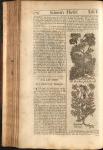Chap. 124. Of Chervil Wild.
 This chapter hasn't been proofread yet.
This chapter hasn't been proofread yet.
I. The Names. It is called in Greek, X*f?ipux-A Acy Ay&ov: In Latin, Cerefolium, or Chere-folium Sylveflre : and in English, Wild Chervil.
II. The Kinds. This is the second Species of Chervils, and is threefold : 1. Cheerophyilum Bau-hini, Cerefolium Sylveflre Vulgare, Common Wild Chervil. 2. Myrrhis JEauicolorum nova Fabij Column*, Small Hemlock Chervil. 3. Cicutaria alba Lugdunenfis, Cicutaria Paluflris Camerarij, Wild Ciiley.
HI. The Descriptions. Wild Chervil, has a whitish woody Rwt from which rise up round about it, round, red, and hairy Stalks, a yard high, or more, many times large, and fwoln about the Joints, which Stalks are not hollow, but full of Pith ; towards the top they are divided into many Branches, which have on their tops Umbles of small and very fine white little Flowers, which being pajjed away, are succeeded by longifh Seeds. The Leaves are commonly parted into three principal parts >, and each part again fubdivided into five, which are fnipt about the edges, soft, hairy, and of a dark green, or reddish color.
IV. Small Hemlock Chervil, has a Root small and white, which when it has perfeUed its Seed, perishes every Year : from which rise up Stalks slender', hol-'M, smooth, not hairy, and seldom exceeding the "eight of two feet. They are divided into Jeveral
Branches, again ft The Leaves, so that they fpftttg out of Bofcms, as it were, of the Leaves, which carry Umbles of small white Flowers; after which jr.-low the Seeds, rough, hairy, round and longijh, about the bigness of Aniieeds, and growing tiw together. The Leaves are- small, and finely cut or divided, like thfe of Hemlock, but of a wbitifl color, and hairy.
V. Wild Ciiley, has a Root very large, and divided into several parts, zohite, an i fpungy, of a plca-fant strong Smell, and with a hot and biting taste : This Root, thd the Stalks fade an I perifi,yet fives, and the Leaves are green all the Tear. The Stalks (if they grow in good ground) come to be three or four feet high, are hollow, jointed, pretty thick, green, and much Crefied, sending forth out of the bofoms of the Lewes many B) ancles, which have on their tops, Umbles of white Plovers, each Flower confiding of five little Leaves of which the lowest Is twice as big as the rest; the 1 wo side o*ies less the uppermofi the leaf of all. The Leaves are large like those 0/Myrrhis, or Sweet Ciiley, but of a d.irk green color ; and those which grow on the Tops of the Stalks, are commonly divided into three parts, and those ag.iin fubdivided into several long sharp pointed and fnipt Leaves, like those in Sweet Ciiley, the Seeds are longifi, round, sharp pointed, black and Jhining. This Plant may very well be called Wild Ciiley, for that it so much resembles the Garden Sweet Ciiley, not only in its firm, but ( as Authors believe ) m its Virtues too.
VI. The Places. The first grows almost in every Hedge, and by every Hedge side : The second, about Mudd Walls, High Ways, and such like places, a-hom London,-did m.my other parrs of the Kingdom : it is but a small Plant. The third is found very frequently in all places, especially where the ground is moist and fat, in Meadows, Orchards, and the like.
VII. The Times. '\h first flowers in June and JuH\ and the Seed ripen* in tlu mean Seaf <n, or
not icug atter. The second comes up in March, Rowers in May, and its Seed ripens in June. In Italy they eat the voting Leaves in Sallets, and call it .Wild Chervil. The third flowers also in May and June, and its Seed ripens in the mean Seafon, or not long after.
VIII The Qualities, Specification, Preparations and Virtues, are laid to be the fame with the Garden Chervils, to which I refer you. Parkinson fays, that Wild Chervil will help to dilfolve any Tumor or Swelling, and that in any part of the Body, as also to take away the fpots and marks in the fleih and Skin, proceeding from Congealed Blood, by bruifes or blows, in a short time, by applying it ( bruised I fuppole ) to the place.
IX. A Cataplasm of the green Herbs and Roots. I once" knew a Man who had been lor a loug time, even lor ninny years, afflicted with the Gout ; fo that sometimes for four, five or fix Months together he could neither go nor ltand, which put him fo much out of heart, as te think himself past all cure. A Beggar AVoman going by, and begging at the Door, at such time as the Paroxyfm was upon him, and underltanding by fome Difcourfes the Matters iilnefs, told them fhe would cure him: fhe advifed him to apply a Pultice of green Wild Chervil to the parts afflicted, and to renew it as often as he faw need: ( fetching to him alfo at the fame time fome of the Herb, that he might know it: ) he did fo, following exactly the Beggar Wo-mans advice, and he had in a little time eafe, and in less than a Months time a perfect Cure. If at any time afterwards he found any Grumbling Pain, in the fame parts, or in any other, he had ftill recourfe to the fame remedy, and averr'd upon his faithful word, that he never apply'd this Cataplasm in
vain.
Botanologia, or The English Herbal, was written by William Salmon, M.D., in 1710.

 Page 211
Page 211 Page 212
Page 212